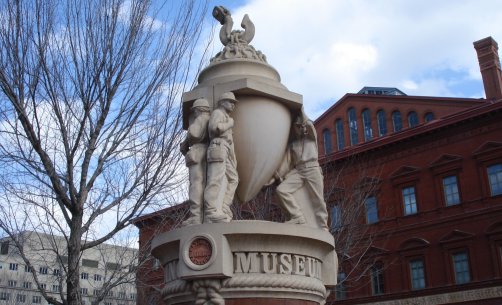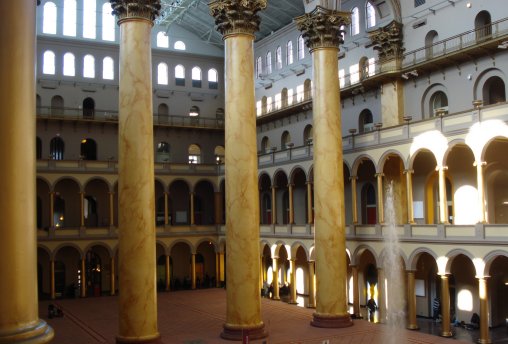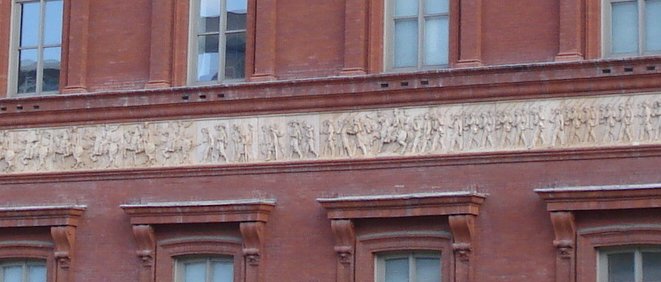Below is the art in front of the Building Museum.

The world is better now than it was a century ago, but we have lost that sense of muscular optimism. Pity. You could read it in their literature and you could see it in their architecture. I was reminded of that today when I went up to the National Building Museum. It was dedicated by President Grover Cleveland and it has all that substantial grandeur common to buildings of that period.
Vast and imposing indoor space is the hallmark of American public buildings from the late 19th and early 20th centuries. They are cathedrals of the Republic.

I went to see the exhibit on green cities. It was not that good for me, although I can see its general value. The whole museum is set up more as a place to bring school kids to learn about these things. I like the concept, though. It is possible to design buildings and whole cities in ways that make them both more pleasant and more environmentally sustainable. We are often confronted by the false choice of either destroying our world or living a Visigoth level of technology and consumption. The correct answer is neither. We can do better.

Implicit in the dilemma is the false premise that people and nature don’t mix and that the best we can do is mitigate or repair the damage we inevitably cause. In fact, humans are an integral part of nature. Some of our activities do indeed damage nature: others improve it. The key goal is to make our existence sustainable for a long, as nothing lasts forever, and the premise of man v nature is not helpful.
In the great scheme of nature, animal and plant life sets the stage for its own local destruction. Pine trees grow so thick that they shade out their own offspring. Grazing animals have to keep moving as they destroy the grass they need to eat. Elephants rampage through the forests they depend on for food. Despite all the Rousseau “noble savage” fantasies, pre-industrial humans were/are that way too, i.e. very destructive. Their populations were sustainable only because their numbers were small enough to minimize the damage. This is the way it works in the animal world; this is how it worked with human populations. People moved away when things got bad or they died off. It was a Malthusian spiral never ending – that is the real circle of life – until our technology and knowledge broke us out of it. Of course, this created a different set of problems.
Below is the frieze on the National Buidling Museum. The building was finished in 1887. It used inexpensive materials, such as brick instead of cut stone.

We humans, alone among the animals so far, have the capacity to see the larger effects of our activities. The game is not over. We may yet suffer the population crash that afflicts animal species when they overrun their habitat’s carrying capacity; but not today or tomorrow. I still have that old fashioned optimism and I have seen the new fangled techniques of environmental restoration or renewal. Things will be tough, but we will get better.
BTW – we look back on the past with some nostalgia because we know how the story came out. It is harder to see forward than look back. We should recall past hard times. The panic (as they called recessions in those days) of 1907 was horrible. Some people actually didn’t get enough to eat; obesity was not a problem of poverty a century ago. The stock market lost more than 50% of its value. In the absence of a central bank (the Federal Reserve was not established until 1913) JP Morgan stepped in to rescue the economy with a private sector bailout. We recovered. This panic was during the time of Theodore Roosevelt. Most of us just remember his muscular optimism and know absolutely nothing about the panic of 1907. That sense of historical amnesia is why our expectations are so high and why we always think we live in the worst of times.
Morgan later went in front of a congressional committee. This is part of the exchange.
Untermyer: Is not commercial credit based primarily upon money or property?
Morgan: No, sir. The first thing is character.
Untermyer: Before money or property?
Morgan: Before money or anything else. Money cannot buy it … a man I do not trust could not get money from me on all the bonds in Christendom.There is a good biography re Morgan by Ron Chenow. I recommend it. I also read his biographies of Alexander Hamilton and John D. Rockefeller (Titan). They are all good books.
